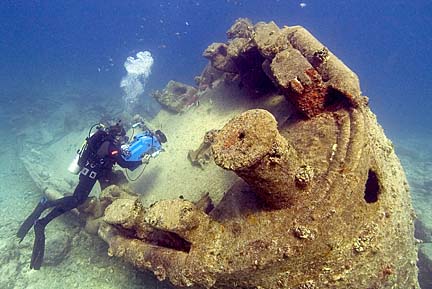
|
Northwest islands trip
yields preservation data
Researchers gather information that could
support the case for a marine sanctuary
Sunburned but satisfied that they exceeded mission expectations, 15 scientists returned to Honolulu yesterday from a 25-day research voyage to the Northwestern Hawaiian Islands.
Working from the National Oceanic and Atmospheric Administration ship Hi'ialakai, the multidisciplinary team:
>> Documented two known shipwreck sites at Pearl and Hermes Atoll, and discovered two more.>> Equipped 70 large predators -- sharks, jacks and snappers -- with acoustic transmitters that will track their movements for two years.
>> Collected genetic samples from fish and other sea animals that will help reveal whether each atoll in the Northwestern Islands is a self-contained "neighborhood," or mixes with the atolls next door.
>> Set up several permanent coral health monitoring sites to observe bleaching and disease.
>> Made detailed maps of 650 nautical miles of ocean floor.
>> Took high-resolution video for educational programs.
Joyce Miller, head of the sonar mapping crew, said she was pleased to finish mapping the boundaries of the 84 million-acre Northwestern Hawaiian Islands Coral Reef Ecosystem Reserve.
The maps go to a 2-meter resolution, showing details like sand waves and coral heads. Knowing the habitat, scientists can project what kind of creatures live in those areas, said Miller, who works for both the Pacific Islands Fishery Science Center and the University of Hawaii's Benthic Habitat Mapping Center.
The Northwestern Islands contain 70 percent of the coral reefs in the United States, and the reserve is in the midst of the multi-year process of becoming the country's 14th National Marine Sanctuary. U.S. Rep. Ed Case also has proposed making the area a marine refuge.
One of the issues facing the remote, near-pristine area is whether to allow fishing to continue there.
Two of the projects begun on this trip directly relate to that issue. The acoustic transmitters on large predators will allow scientists to see whether they stay in one area, or travel from island to island in the chain, said Randy Kosaki, a fish biologist and research coordinator for the voyage. Similar studies have been done on one kind of shark, but never this many large predators.
Brian Bowen, a conservation geneticist at the UH Institute of Marine Biology, said learning whether each reef and atoll in the chain is self-contained will be significant. If fish and other animals don't mix among the atolls, the whole system would be considered more "fragile," he said.
The genetic work on samples taken from fish and invertebrates during the trip will take about a year to yield preliminary results, Bowen said.
Meanwhile, Hans Van Tilburg called himself the "luckiest marine archeologist in the world" to study the probable wrecks of the British ships the Pearl and Hermes, which wrecked in 1822 on the reef later named for them.
"In 15 years, I've never seen one trypot (cauldron for rendering whale oil), let alone four in the same place," said Van Tilburg, National Marine Sanctuary Program maritime heritage coordinator for the Pacific. "It's rare to find sites like that."
"It was great to be on the exact spot that it happened," Van Tilburg said of diving at the wreck sites. "It's kind of eerie sometime."
Discovered on this trip were a barge at French Frigate Shoals and a modern vessel lost at Pearl and Hermes Atoll in 1989. Also found: a trail of coal off Kure Island, possible clue to yet another shipwreck in the area.
|
E-mail to City Desk
[News] [Business] [Features] [Sports] [Editorial] [Do It Electric!]
[Classified Ads] [Search] [Subscribe] [Info] [Letter to Editor]
[Feedback]
